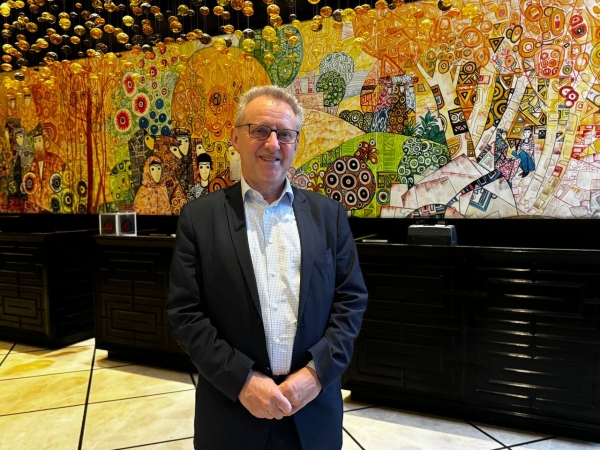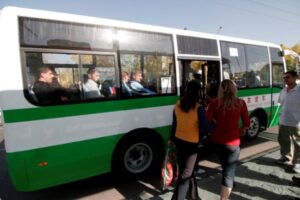
Vienna – A Smart City of the Future: What Can Dushanbe Learn?
Vienna is one of the first cities in the world to set the goal of becoming a digital smart city. What lessons can Dushanbe take from this?
During a visit to Dushanbe, we spoke with Ernst Woller — President of the Vienna State Parliament. He shared insights about Vienna’s digital transformation as one of Europe’s first smart cities, and what it means to create a comfortable living environment.
— Mr. Woller, have you had a chance to enjoy Dushanbe yet?
— I arrived just last night, so I haven’t had much time, but I did take a short walk around the city and I really liked it here. This is my first visit to Dushanbe and to Tajikistan overall. In fact, this is the 100th country I’ve visited.
— Congratulations! Could you please tell us a bit about yourself and the purpose of your visit?
— I have been the President of the Vienna State Parliament for seven years, and I’ve served in the Vienna City Parliament for a total of 37 years. For a long time, I chaired the Cultural Affairs Committee, and since 2018, I’ve held my current position. I came to Tajikistan to exchange experiences — for us, this is a very important opportunity.
— You have extensive experience with the Smart City project in Vienna. What role have you played in this process?
— – Yes, I do have a lot of experience in smart city projects, as they are very important for Vienna. We’ve been working on this for over 15 years and have received numerous international awards in this area. The most notable is the Lee Kuan Yew World City Award of Singapore. In 2022, Vienna was recognized as the best smart city in the world. That’s why we’re organizing the World Cities Forum in Vienna this July.
— If I’m not mistaken, Vienna was one of the first smart cities in Europe?
— That’s correct. We even have a dedicated Smart City Agency that works on these issues. We’ve adopted the "Smart City" strategy twice and we implement it across all areas — not just urban planning.
Insert:
— Can you give concrete examples of how Vienna became a smart city?
— Over the past 35 years, the city’s population has grown by 500,000 — that’s a one-third increase. However, the city’s area has remained the same. Despite the population growth, we managed to maintain and even improve the quality of life. Vienna has been ranked the most livable city in the world for 15 years in a row.
We also increased the share of green spaces from 50% to 53%, partly by greening building facades. Now, the city has over 200 such “green buildings.”
— What do you mean by "green buildings"? Is it about eco-friendly construction or buildings with plants?
— Both. We build eco-friendly structures, but we’ve also added greenery to existing buildings. We planted vegetation in front of facades, and it grew quickly.
Now, years later, those 200 buildings are completely covered in greenery — from the ground to the rooftop.
— So, would you say that the smart city concept is closely tied to ecology?
— Ecology is one of the key factors of a smart city. We believe a smart city truly develops only when quality of life improves, green areas expand, and the environment gets better. We've made significant progress in this direction, including through digitalization — not for the sake of technology itself, but for the benefit of people and society.
We also promote sustainable mobility: encouraging cycling, walking, and especially the use of public transportation.
Today, more than 40% of our residents use public transport to get around, while only 25% rely on personal cars.
-We have almost 830,000 people with annual public transport passes (which cost just 365 Euros per year, or 1 euro per day). At the same time, there are only about 700,000 privately owned cars — fewer than public transport users. This is a result of both digitalization and smart transport policies.
— You mentioned digitalization. What exactly do you mean in the context of a smart city?
— We use street cameras, but maybe not the same way as in Dubai, China, or perhaps even Dushanbe. For example, we use them to monitor which cars enter the city center and to restrict traffic in that area. The goal is to reduce car usage.
Also, if someone needs to request or access information from the city — like applying for something or getting documents — it can all be done online.
For example, our parking system allows you to park only in your residential district, not in others. This encourages people to leave their cars at home and not drive all over the city.
— Parking is a very relevant issue in Dushanbe. A paid parking project started about a year ago. How is it handled in Vienna?
— In Vienna, more than 260,000 people live outside the city but commute here for work. They can’t park on city streets for free — they have to pay.
We also have short-term parking zones where you can park only for 90 minutes. You can’t leave your car there all day, and the entire stay is paid. We are also developing a system to restrict access to the city center.
For long-term parking, you can only leave your car in your own district — not wherever you like, such as near a friend’s home.
— So, the goal is to encourage people to use public transportation?
— Exactly. We want people to take public transport, ride bicycles, or walk. We've seen good results — now more people use public transportation than personal cars.
It’s also a matter of mindset: if you own a piece of land and build on it, you have to pay. But if you park a car on it, many assume it should be free. However, even a parking spot is part of the city’s shared space. Land in our city is limited, so parking isn’t free by default.
— Have you faced challenges when introducing digital services to the public? Many people are still not used to online tools.
— Yes, especially among older people. That’s why we offer both online and traditional service options. We also run digital skills courses — but they’re voluntary.
— Based on your experience, what advice would you give to cities that are just beginning their smart city journey?
— I would recommend not trying to do everything at once. It’s important to identify priorities — whether it’s ecology, transport, or digital services. Start small and involve the population at every step. People need to understand why things are being done and how it benefits them. Only then will the project succeed.
— You mentioned citizen involvement. How important is it in smart city development?
— It’s essential. We regularly hold surveys, discussions, and forums. We even have online platforms where residents can make suggestions. For example, we have a platform called "Sag’s Wien" — “Tell Vienna.” On this site, you can ask any question related to city life or report an issue — like a broken pedestrian area or anything unusual in your neighbourhood. It’s a simple way to maintain dialogue between citizens and city services.
For example, residents once suggested creating new cycling routes — and it was implemented. Citizen involvement increases trust in government and makes the city truly “smart,” because it develops based on the needs of the people.




